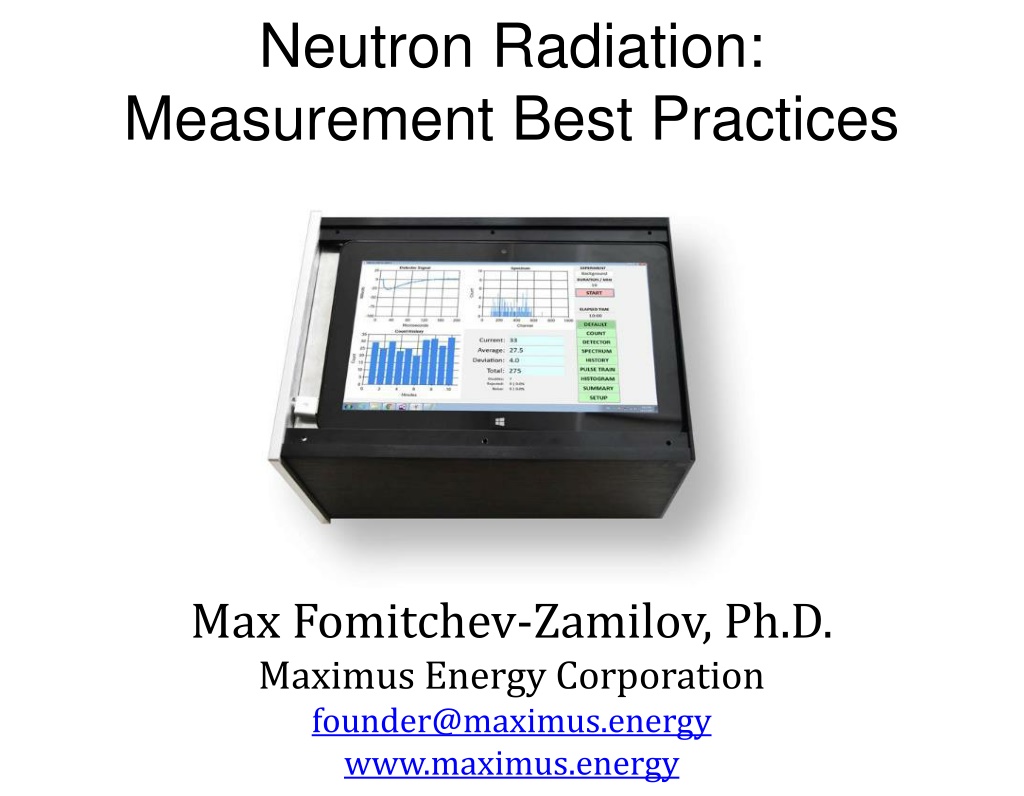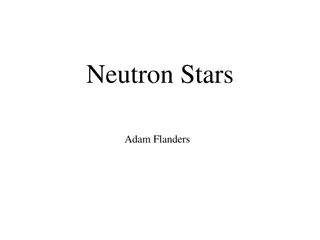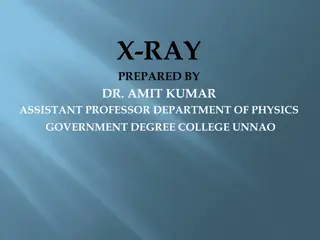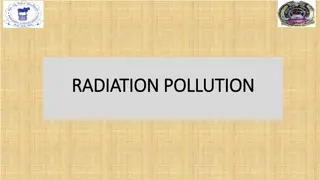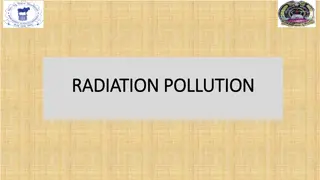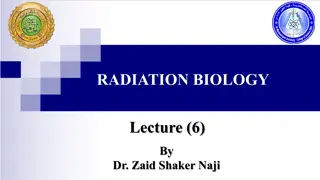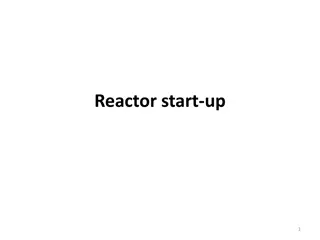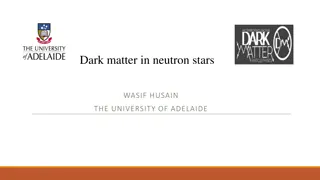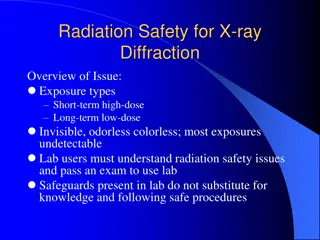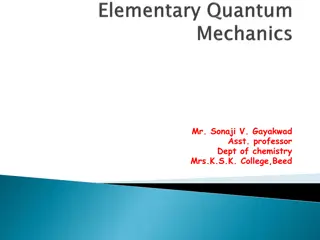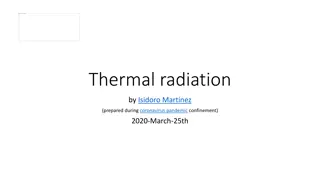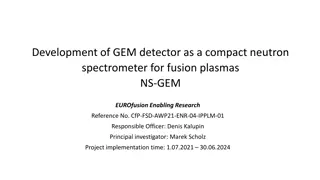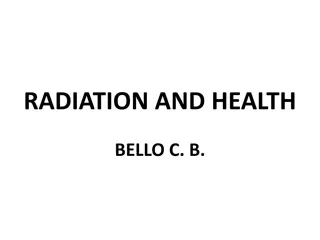Neutron Radiation Measurement Guidelines and Techniques
Understanding neutron detection basics, absorption cross-section, moderators, positioning, and common detector types is crucial for accurate measurements. Neutrons vary in energy levels, requiring specific detection techniques. Thermal neutrons are easier to detect than fast ones, with materials like Helium-3 and HDPE being effective detectors and moderators. Proper moderator positioning is essential based on neutron energy levels. Various detector types, such as proportional counters and crystal scintillators, offer different sensitivities and capabilities for neutron detection and analysis.
Download Presentation

Please find below an Image/Link to download the presentation.
The content on the website is provided AS IS for your information and personal use only. It may not be sold, licensed, or shared on other websites without obtaining consent from the author.If you encounter any issues during the download, it is possible that the publisher has removed the file from their server.
You are allowed to download the files provided on this website for personal or commercial use, subject to the condition that they are used lawfully. All files are the property of their respective owners.
The content on the website is provided AS IS for your information and personal use only. It may not be sold, licensed, or shared on other websites without obtaining consent from the author.
E N D
Presentation Transcript
Neutron Radiation: Measurement Best Practices Max Fomitchev-Zamilov, Ph.D. Maximus Energy Corporation founder@maximus.energy www.maximus.energy
Neutron Detection Basics Neutrons can be broadly classified as: Fast: Ek > 1 MeV, Slow: Ek~ 10 eV, Thermal: Ek~ 0.025 eV. Each class requires it s own special detection technique. Neutrons are usually rare: statistical analysis is necessary! Natural neutron background can vary wildly: statistical analysis in necessary! Detection probability exponentially increases with the decrease in neutron energy.
Neutron Absorption Cross-Section A thermal neutron is ~10 000 easier to detect than a fast one! Helium-3 is almost 10 times more sensitive to thermal neutrons than Lithium-6.
Neutron Moderators Hydrogen Water, oil, organics High-density ultrahigh molecular weight polyethylene (HDPE) Absorbs thermal neutrons Deuterium Heavy water Expensive Graphite Must be boron-free Beryllium Expensive, dust is very toxic (hence difficult to machine)
Moderator Positioning Extended Source Compact Source Detector Detector Moderator Moderator Optimal moderator thickness depends on neutron energy: Fast neutrons: 5-10 cm of HDPE Thermal neutrons: moderator not needed! It will absorb them Cold neutrons: will be absorbed by environment, even by the air
Common Neutron Detector Types Thermal neutrons Proportional counters:3He, 10BF3, 10B Corona mode counters: typically stronger single than proportional counters Fast neutrons:4He, CH4, liquid scintillators Crystal scintillators: 6Li glass, NaI(Tl + Li) Bubble detectors Track detectors: CR39 Solid-state:6LiF6, 10B over silicon diode
Proportional Counters3He / 10BF3 / 10B Very high thermal neutron sensitivity Sensitive to electromagnetic interference Sensitive to gamma radiation, gamma rejection is a must Old soviet SHM-18, SI-19N are good for research
6Li Glass Crystal Scintillators High thermal neutron sensitivity Not as sensitive to EM interference as proportional counters Sensitive to gamma radiation, gamma rejection is a must
Bubble Detectors Made by Bubble Technology Industries (BTI), Canada Made for different energy ranges (e.g. one can order a 6-vial spectrometer) + Insensitive to electromagnetic interference, x-ray or gamma radiation + Inexpensive: ~$300 ea. Low neutron sensitivity (~1000 less than 3He) Useful life: 1-2 years Sensitive to vibration, shock and heat (cause bubbles)
CR39 Plastic Track Detector Widely available from Landauer, USA + Gold standard for publication + Very inexpensive: ~$20 ea. under dosimetry subscription service Do not provide real-time counts: require etching and counting under microscope (automated under Landauer subscription service) Very low sensitivity (10,000 less than3He)
Neutron Activation 1) Irradiate indium, gold, silver or europium foil 2) Acquire gamma spectrum Requires large (3-5 ) NaI or germanium (HPGe) detector in a lead shield
Proportional Counter Properties 3He gas pressure: 0.5 20 bar SI-19N/SNM-18: 2-3 bar Dimensions: diameter 5-50 mm, length up to 2 m Bias voltage: 800-1,500V Pulse amplitude: 10-100 mV Pulse rise time: 1-20 s Background: 1-5 CPM* Efficiency: 60-90%* Sensitivity: depends on geometry, gas pressure: CPS/nv counts per second per neutron per 1 cm2.
General Counter Diagram Bias Power Supply Counter Filter Detector Preamp Discriminator Short Cable Long Cable
Do Not Use Black Box Systems Interference Incorrect Measurements Black box systems are not suitable for scientific studies
Simplified Detector Schematics Bias Power Supply Detector Filter Preamp Computer
NEUTRON-PRO System http://maximus.energy/index.php/product/neutron-pro/
PulseCounter Software http://maximus.energy/index.php/software/
3He Counter: Proportional Mode Baseline: 0V Trigger level: -5 mV Pulse amplitude: 25 mV Pulse width: ~100 s Pulse rise time: 12 s
3He Counter: Corona Mode Corona noise Trigger level (discriminator) Purported neutron pulse
Thermal Neutron Spectrum Thermal peak: 764 keV Proton continuum to 573 keV Triton continuum to 191 keV
Gamma Rejection Gamma peak Gamma peak creeps to the right as the intensity of x-rays increases Neutron spectrum
Gamma Rejection Neutron detector overwhelmed by x-rays
Neutron Check Source Nuclespot P2042 5 mCi 210Po alpha source available at www.amstat.com Cover with beryllium and obtain a check source on the order of few thousand of neutrons per second! People also use 241Am, 239Pu from smoke detectors Few-Ci 252Cf calibration source is the best but it is expensive and requires an NRC license
Systematic Errors 1) Proportional counters are very sensitive to EM interference! Intrinsic noise may cause false low-energy peaks and may affect the counting rate! Periodic EM noise (e.g. power supply noise) may add a parasitic periodic component to the counting rate! 2) Gamma radiation requires careful gamma rejection. 3) Bias or amplifier drift may impact the counting rate! 4) Natural neutron background may vary wildly, especially when too few measurements are taken. 5) Human body is a good moderator, may affect the counting rate.
Random Processes We are dealing with random processes. That is why we cannot draw conclusions after making only 1-2 (or a handful) of measurements; Too few measurements can yield odd patterns, including some pretty incredible ones; Non-repeatable results are (most likely) just odd samples drawn from random distribution.
Statistical Analysis 1) Sample the background: 20 samples 2) Sample the experiment: 20 samples 3) Calculate P-value: if the value is less than 5% it is customary to consider the difference between the experiment and the background to be statistically significant . If the P-value changes significantly with the addition or removal of samples you do not have enough samples in your data set.
Statistical Analysis: Example #1 P-value = 0.0007 !!! Interesting But too few (<30) measurements to be convincing
Statistical Analysis: Example #2 Interesting But this is just a lucky pattern
Statistical Analysis: Example #3 One cannot discard lower experiment counts as errors
Neutron Detection Best Practices Configuration Cover the detector in lead foil to suppress gamma Use moderator: 2-4 of HDPE is usually enough Place the detector and all the electronics in a metal enclosure (Faraday cage) Employ battery power to avoid ground loops Record the detector signal for off-line analysis and pulse shape audit Calibration Use a neutron check-source (e.g. 5 mCi Po-Be) to check the detector: the detector must respond to the source Use a gamma source (e.g. 10 Ci 137Cs) to verify gamma rejection: the detector must not respond to the source
Neutron Detection Best Practices Experiment Place the detector as close to the purported neutron source as possible Use gamma detector for gamma intensity & spectrum monitoring Statistical Analysis Check background regularly: record 20+ measurements each time Record 20+ experiment measurements each time Calculate P-value Statistics will improve with the increase in the number of measurements Secondary Means of Confirmation Use bubble detector to verify / confirm the neutron flux If the neutron flux appears large use indium foil activation to verify / confirm the neutron flux
Useful Resources http://maximus.energy/index.php/product/neutron -pro/ http://bubbletech.ca/product_type/bubble- detector-products/ https://amstat.com/esd-ionizer/nuclespot-alpha- ionizer/
